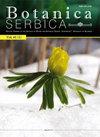An insight into seasonal changes of carbohydrates and phenolic compounds within the moss Polytrichum formosum (Polytrichaceae)
IF 1.1
4区 生物学
Q4 PLANT SCIENCES
引用次数: 0
Abstract
The same population of the polytrichaceous moss Polytrichum formosum was studied over four different periods of the year, analysing its carbohydrate and polyphenolic content and dynamics related to environmental seasonal changes. A total of 18 different types of sugars (including mono-, di-, tri- and tetra-saccharides) and four sugar alcohols were determined. Chlorogenic acid was the most represented among the 10 detected phenolic compounds. As inferred by the sugar content, sucrose, fructose and glucose were the most dominant sugars, but it is worth mentioning the abundance of trehalose and turanose at least during one of the observed seasons. The presence of four trisaccharides and one tetrasaccharide within P. formosum should be highlighted, as well as the first reports of turanose, isomaltotriose, panose and rhamnose within this species. The quantitative changes over the year clearly demonstrate carbohydrate dynamics in relation to seasonal climatic variation. Sugars are shown to be significant constitutive molecules within P. formosum, but also physiologically active compounds, i.e. signalling and energy storage and supplier molecules. We assume that phenolics have moss-supportive effects during oxidative stress and biotic interaction.苔藓中碳水化合物和酚类化合物的季节变化
对同一种群的多毛藓(Polytrichum formosum)在一年中的四个不同时期进行了研究,分析了其碳水化合物和多酚含量及其与环境季节变化的动态关系。共测定了18种不同类型的糖(包括单糖、二糖、三糖和四糖)和4种糖醇。绿原酸在10种检测到的酚类化合物中最具代表性。根据糖含量推断,蔗糖、果糖和葡萄糖是最主要的糖,但值得一提的是,至少在一个观测季节,海藻糖和turanose的丰度很高。值得注意的是,该物种中含有四种三糖和一种四糖,以及首次报道的土聚糖、异麦芽糖糖、糖糖和鼠李糖。全年的数量变化清楚地表明碳水化合物的动态与季节气候变化有关。糖被证明是台湾草木中重要的组成分子,但也是生理活性化合物,即信号和能量储存和供体分子。我们假设酚类物质在氧化应激和生物相互作用中具有支持苔藓的作用。
本文章由计算机程序翻译,如有差异,请以英文原文为准。
求助全文
约1分钟内获得全文
求助全文
来源期刊

Botanica Serbica
Agricultural and Biological Sciences-Plant Science
CiteScore
1.40
自引率
12.50%
发文量
17
审稿时长
34 weeks
期刊介绍:
Botanica Serbica publishes original research papers on all aspects of plant, fungal and microbial biology research including the disciplines of microbiology, mycology, lichenology, bryology, flora, vegetation, biogeography, systematics, taxonomy, plant biotechnology, plant cell biology, plant ecology, environmental plant biology, forestry, genomics, horticulture, limnology, metabolomics, molecular biology, proteomics, virology, plant conservation and protection, and wildlife and ecosystem management.
 求助内容:
求助内容: 应助结果提醒方式:
应助结果提醒方式:


